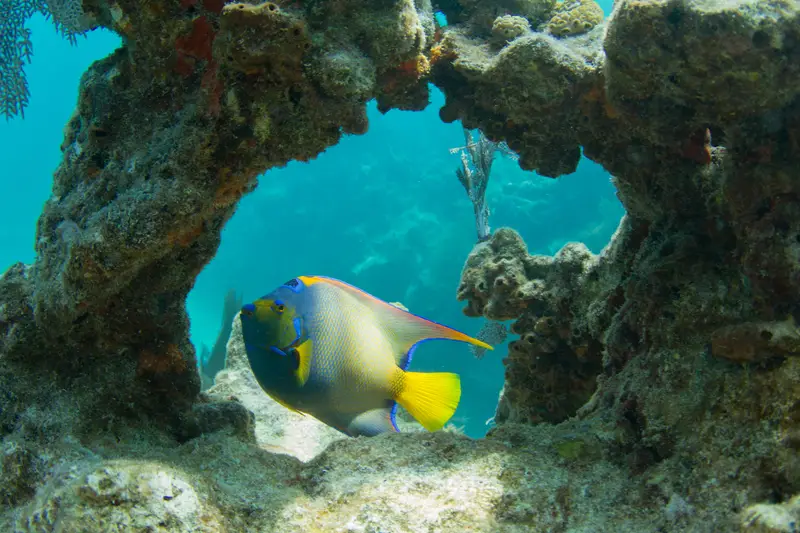
Welcome to the enchanting underwater world of Florida’s vibrant coral reefs, where a kaleidoscope of colors and a symphony of marine life unfold beneath the warm, sun-kissed waters. Among the most captivating residents of these reefs are the popular reef fish that grace the Atlantic waters along the state’s coastline. From the playful dance of the sergeant majors to the stealthy elegance of the moray eels, each species contributes to the intricate tapestry of Florida’s underwater ecosystems. In this article I share my 20 favorite fish species when snorkeling in Florida.
1. French Grunts
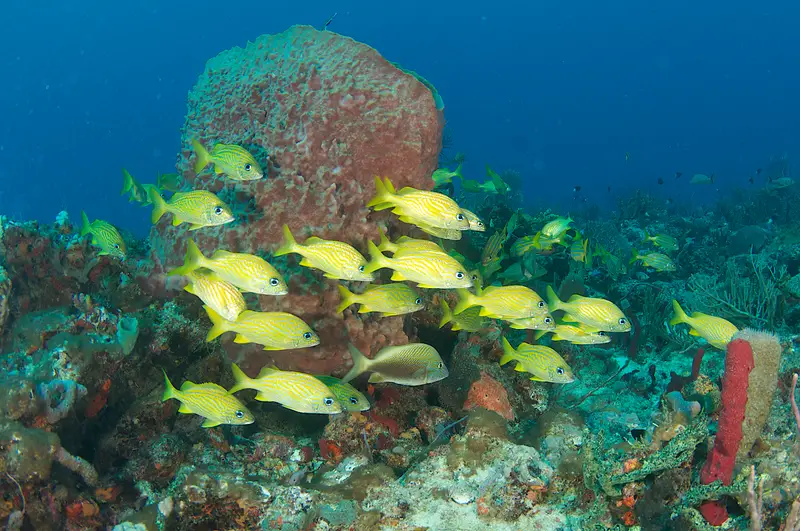
French grunts (Haemulon flavolineatum), also known as yellow-striped grunt, inhabit the warm waters of the western Atlantic Ocean, particularly the Caribbean and the Gulf of Mexico. These dazzling fish are named for the distinctive bright yellow stripes that adorn their silver bodies, creating a visually striking appearance.
French grunts are characterized by their unique behavior and social structure. They are often found in large schools, creating a mesmerizing spectacle as they move in unison through the coral reefs and rocky crevices. This social nature serves not only as a means of protection against predators but also as a way to efficiently forage for small invertebrates and zooplankton.
2. Blue Striped Grunts
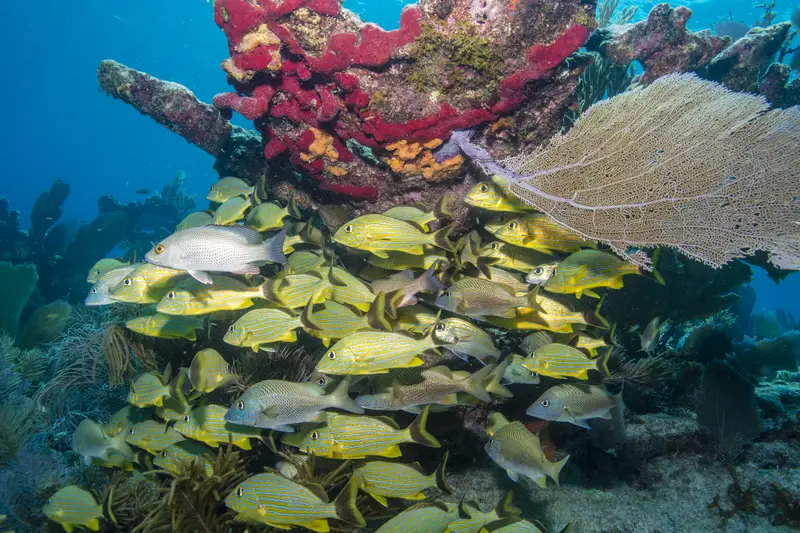
Blue striped grunts (Haemulon sciurus) are a spectacle of nature in the vibrant world beneath the ocean’s surface. These alluring marine fish, found in the Western Atlantic, including the Gulf of Mexico and the Caribbean Sea, boast a distinctive allure with their silver bodies embellished by horizontal blue stripes.
In the ballet of the sea, blue striped grunts are social virtuosos, forming expansive schools that gracefully navigate through coral reefs and rocky coves. Their synchronized movements not only create an underwater visual feast but also serve as a strategic defense against potential predators, showcasing the harmonious synergy of life beneath the waves.
3. Trumpetfish
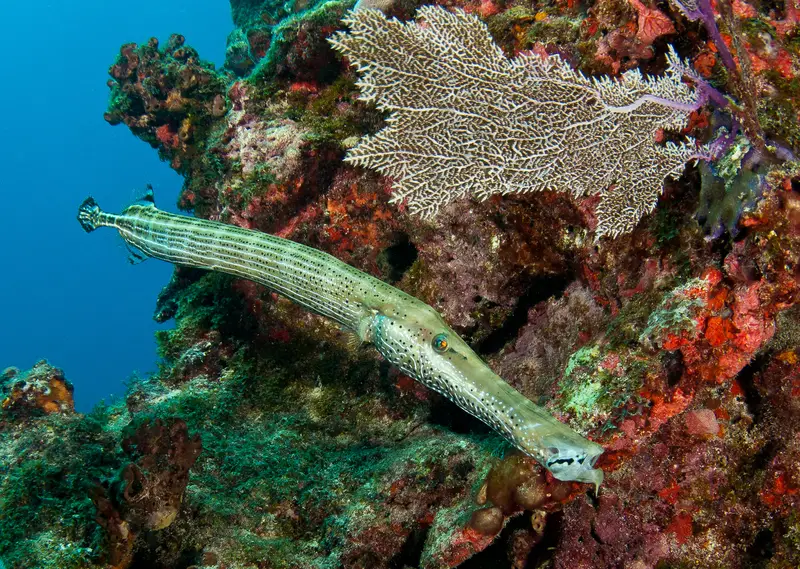
On of my favorite fish in Florida is the intriguing trumpetfish (Aulostomus maculatus). These enigmatic creatures, found in tropical and subtropical waters, have a peculiar and elongated body, resembling a slender tube or, as the name suggests, a miniature trumpet.
Trumpetfish are masters of disguise, effortlessly blending into their surroundings with their ability to change colors to match the hues of coral reefs and seagrass beds. This remarkable camouflage serves not only as a means of concealment from predators but also as a stealthy strategy for ambushing prey. With a patient demeanor, they hover motionless, waiting for unsuspecting smaller fish to come within striking distance.
4. Banded Butterflyfish
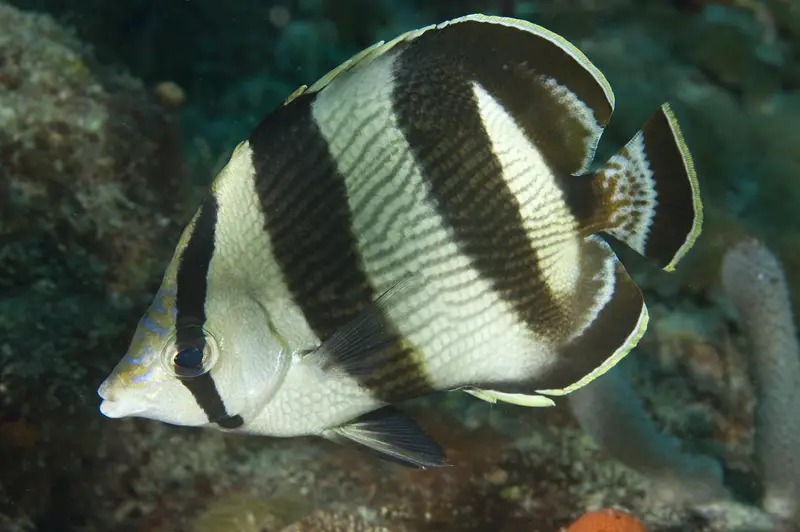
The banded butterflyfish (Chaetodon striatus) is a bewitching species that graces the tropical waters of the Western Atlantic. These charming fish are adorned with distinctive vertical black bands across their yellow bodies.
Banded butterflyfish are social poets, often seen gliding gracefully in pairs or small groups. Their cooperative dance among coral branches and rocky crevices is a testament to the intricate bonds formed in their underwater society. With a fluttering elegance, they navigate through the coral maze, showcasing a synchronized ballet that enchants observers.
Intriguingly, banded butterflyfish are known for their monogamous tendencies, forming long-term partnerships with a single mate.
5. Gray Angelfish
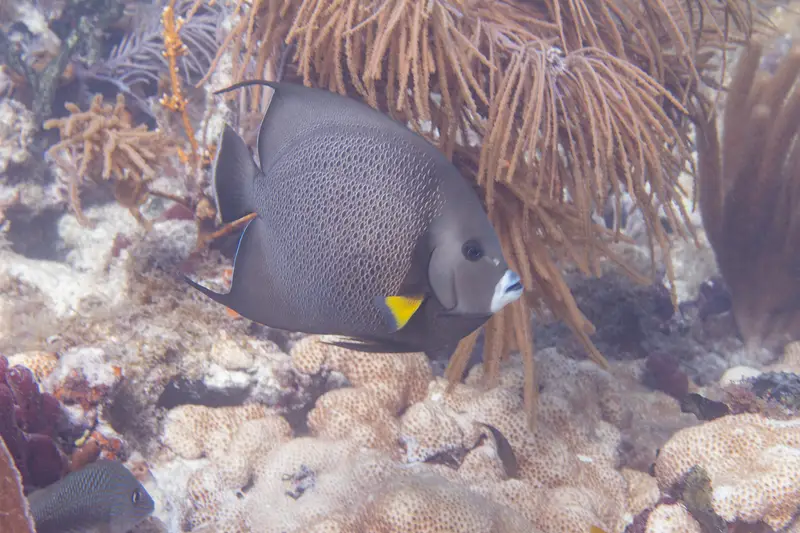
Gray angelfish (Pomacanthus arcuatus) can be recognized by their celestial silvery-gray bodies adorned with vertical black bars. Their fluid movements, a ballet of grace, take them through the intricate coral labyrinths where they feed on sponges, tunicates, and algae. As diligent gardeners of the reef, they contribute to the delicate equilibrium by controlling the growth of these organisms.
What sets the gray angelfish apart is their celestial romance, as they often form monogamous pairs that traverse the coral expanse together. This harmonious partnership not only adds a touch of romance to the underwater realm but also reinforces their commitment to navigating the challenges of the reef environment.
6. French Angelfish
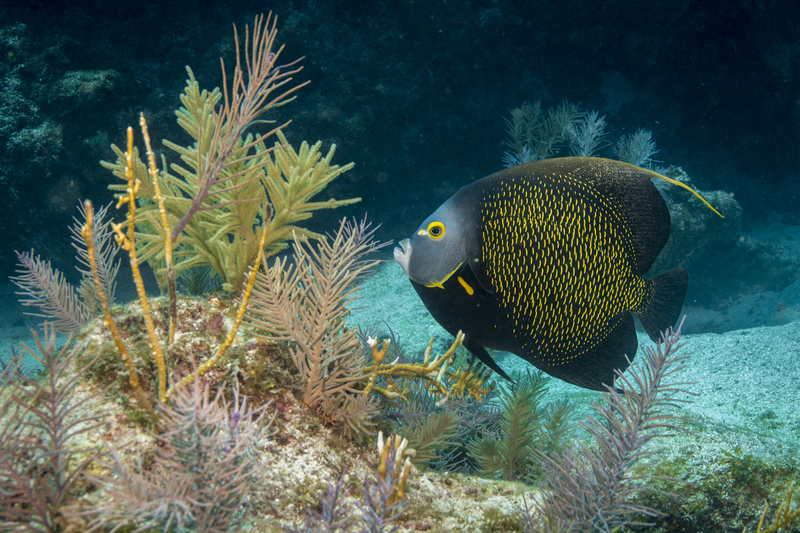
The French angelfish (Pomacanthus paru) is a striking and charismatic species found in the warm waters of the Western Atlantic Ocean. Known for its vibrant coloration and distinctive markings, the French angelfish boasts a deep royal blue body adorned with bright yellow scales and a distinctive black ‘mask’ over its eyes.
These reef-dwelling fish navigate the intricate coral formations with finesse, showcasing an agile and graceful swimming style. Their diet primarily consists of sponges, algae, and small invertebrates. French angelfish are often observed in pairs or small groups, engaging in intricate social behaviors. These fish form monogamous pairs and exhibit territorial tendencies, establishing and defending their space within the coral habitat.
7. Queen Angelfish
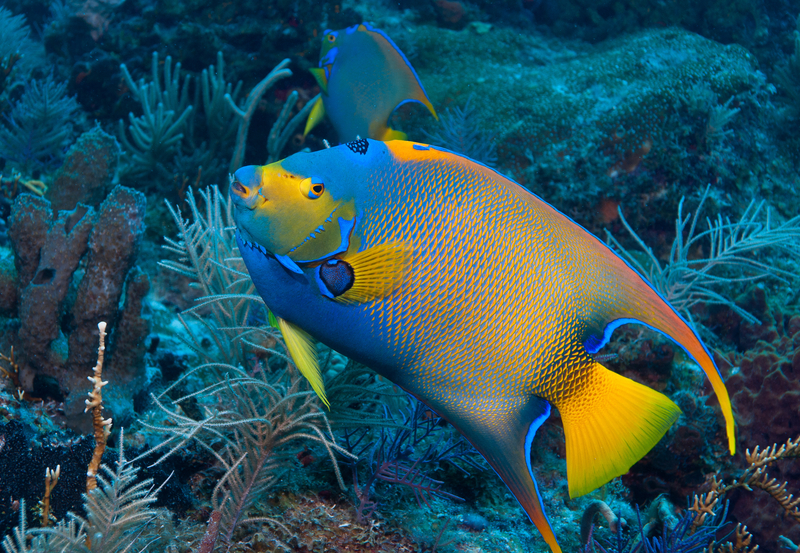
The queen angelfish (Holacanthus ciliaris) is a regal and captivating marine species found in the warm waters of the Western Atlantic, particularly in the Caribbean Sea and the Gulf of Mexico. Renowned for its stunning and vibrant appearance, the queen angelfish is adorned with a resplendent palette of electric blues, purples, and yellows.
These fish are often recognized by their intricate and ornate markings, featuring bright yellow and blue stripes, a dark mask over the eyes, and an elegant trailing “crown” on their heads. Queen angelfish glide gracefully through coral reefs, utilizing their striking appearance not only for camouflage among the intricate coral formations but also to communicate with other members of their species. These fish are often encountered in pairs or small groups.
8. Goliath Grouper
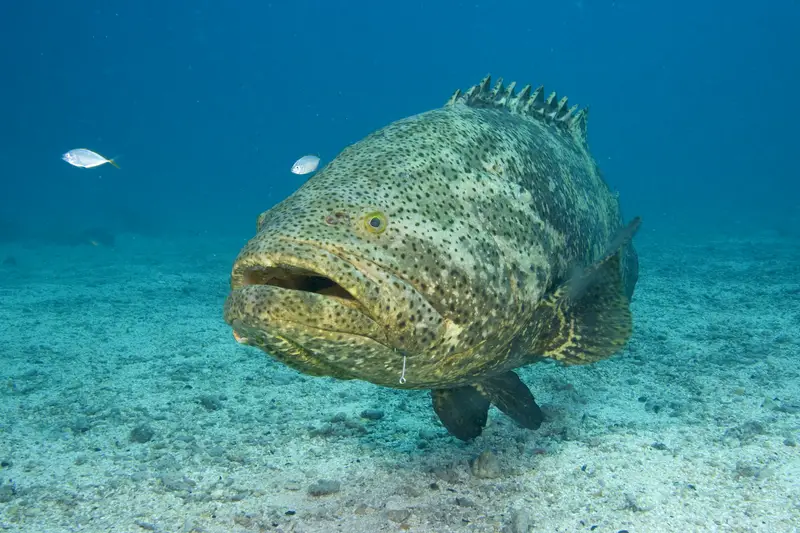
The Goliath grouper (Epinephelus itajara) is a colossal and iconic species of fish inhabiting the warm waters of the Atlantic Ocean, particularly along the southeastern United States, the Gulf of Mexico, and the Caribbean. Known for its impressive size and robust build, the Goliath grouper holds the title of one of the largest reef-dwelling fish in the world.
These massive groupers exhibit a distinctive appearance with a thick, mottled body, and a broad head. They can reach lengths exceeding 8 feet and weigh several hundred pounds, presenting a formidable presence in their coral reef habitats.
9. Blue Tang
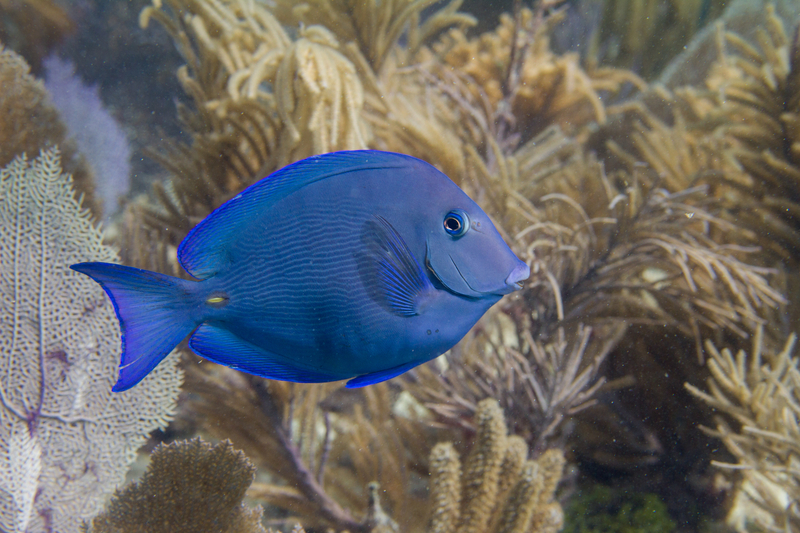
The blue tang (Paracanthurus hepatus) is a captivating marine fish native to the Indo-Pacific region, including the Great Barrier Reef. Its most distinctive feature is its bright royal blue body, sometimes adorned with a striking yellow tail and a black marking near the eyes.
Blue tangs are known for their unique disk-shaped bodies and a set of spines on either side of their tails, serving as a form of defense against potential predators. They play a vital ecological role as herbivores, primarily grazing on algae within coral reefs. This feeding behavior helps maintain the balance of the reef ecosystem by controlling the growth of algae.
10. Scrawled Cowfish
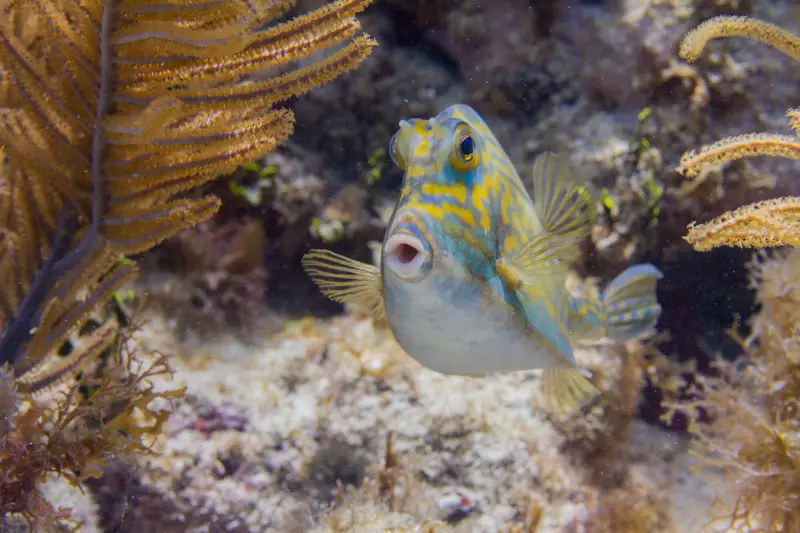
The scrawled cowfish (Acanthostracion quadricornis) is a unique and intriguing marine fish found in the tropical waters of the Western Atlantic. This species is characterized by its distinctive appearance, featuring a box-like body covered in scrawled patterns and armed with sharp spines.
The scrawled cowfish is easily recognizable by its unusual shape and coloration, often displaying a combination of muted hues such as browns, greens, and yellows. Their ability to change color provides them with a certain level of camouflage, allowing them to blend into their surroundings.
These fish are not strong swimmers and rely on their pectoral fins to navigate through the coral reefs and sandy bottoms they inhabit. The scrawled cowfish feeds on a diet consisting mainly of small invertebrates, algae, and zooplankton.
11. Yellowtail Snapper
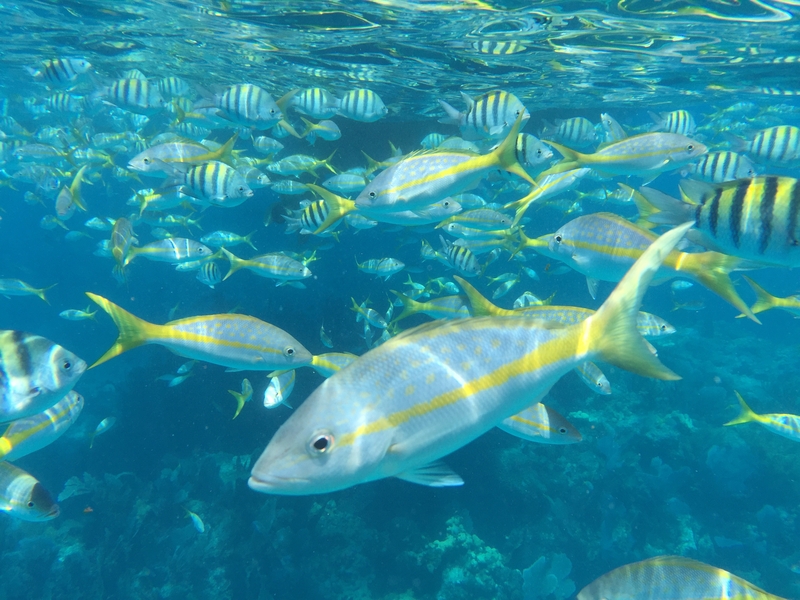
The yellowtail snapper (Ocyurus chrysurus) is a vibrant and popular marine fish found in the warm waters of the Western Atlantic Ocean, particularly in the Caribbean Sea and the Gulf of Mexico. This species is characterized by its sleek, streamlined body, vivid yellow tail, and a distinctive lateral line that runs along its sides. The rest of the body often exhibits shades of pink, silver, or yellow. Yellowtail snappers are typically found in schools, gliding above coral formations and sandy bottoms.
As opportunistic feeders, yellowtail snappers have a varied diet that includes small fish, crustaceans, and invertebrates. Yellowtail snappers are known for their cautious nature, making them both a challenging catch for fishermen and a subject of interest for marine enthusiasts.
12. Great Barracuda
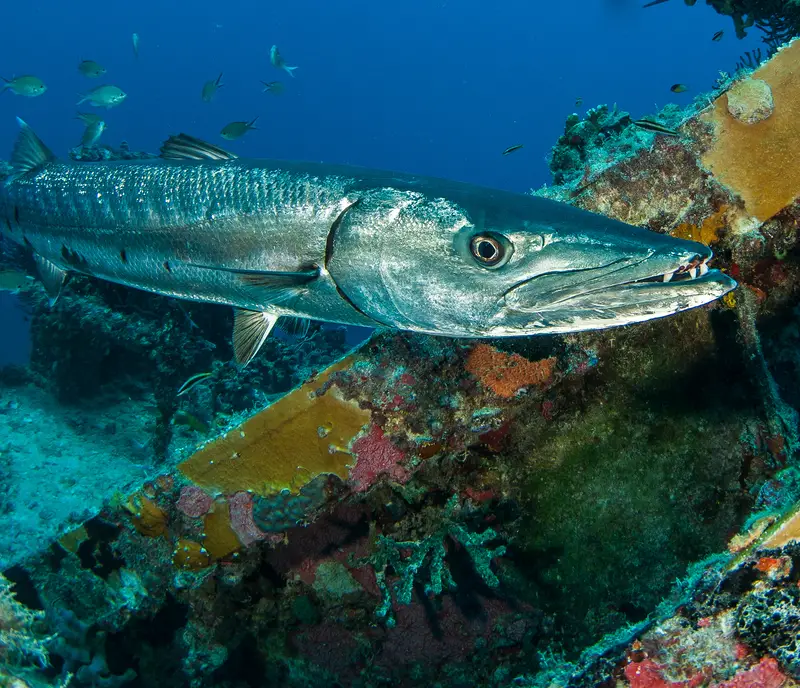
The great barracuda (Sphyraena barracuda) is a formidable and predatory fish inhabiting tropical and subtropical waters around the world. Known for its sleek and powerful appearance, the great barracuda is a top-level predator in marine ecosystems, often patrolling coral reefs, seagrass beds, and coastal waters.
These fish are characterized by their long, cylindrical bodies, sharp-toothed jaws, and a silver or gray coloration that provides effective camouflage in open water. The great barracuda is known for its impressive speed and agility, making it an adept hunter capable of ambushing prey with sudden bursts of speed.
Great barracudas primarily feed on smaller fish, including reef fishes, and are opportunistic predators, occasionally preying on crustaceans and squid.
13. Sergeant Major
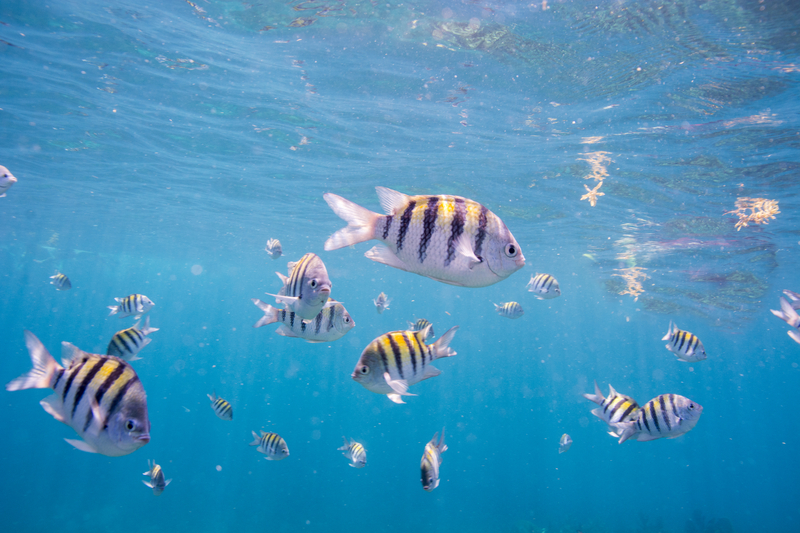
The sergeant major (Abudefduf saxatilis) is a colorful and widespread marine fish found in tropical and subtropical waters around the world, particularly in the Atlantic, Pacific, and Indian Oceans. Named for its distinctive coloration resembling military insignia, the sergeant major is a common sight in coral reefs and rocky coastal areas.
This fish is characterized by its oval-shaped body, vibrant yellow color, and five dark vertical bars on its sides. The striking coloration serves as both a form of camouflage among coral and a means of communication within its social groups.
Sergeant majors are often observed in large schools, creating a lively and dynamic presence in their underwater habitats. Within these schools, they engage in social behaviors, establish territories, and participate in courtship displays.
14. Scrawled Filefish
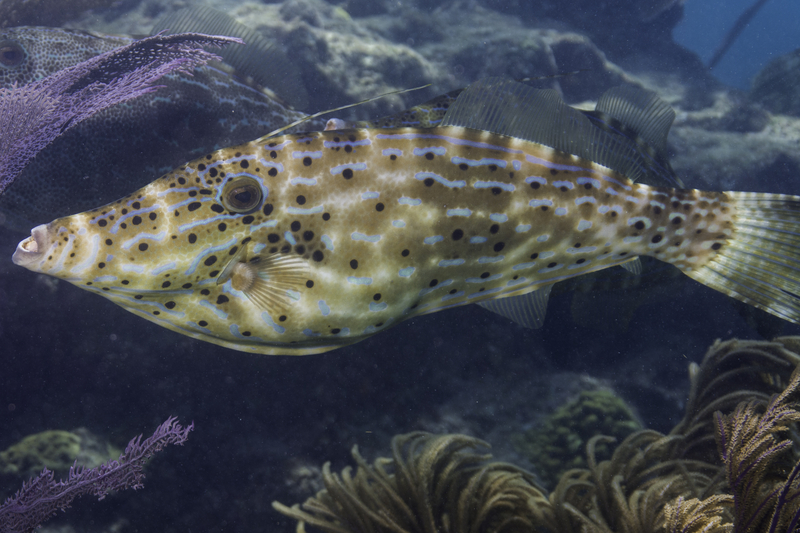
The scrawled filefish (Aluterus scriptus) is an intriguing and distinctive marine fish found in tropical and subtropical waters around the world. Its name is derived from the scrawled patterns and markings that adorn its body, creating a unique and captivating appearance.
Characterized by an elongated body and a small, protruding snout, the scrawled filefish exhibits a variety of colors, including shades of green, brown, and yellow. These colors, combined with its intricate patterns, provide effective camouflage, allowing the fish to blend seamlessly into its surroundings, particularly among coral reefs and seagrass beds.
15. Porkfish
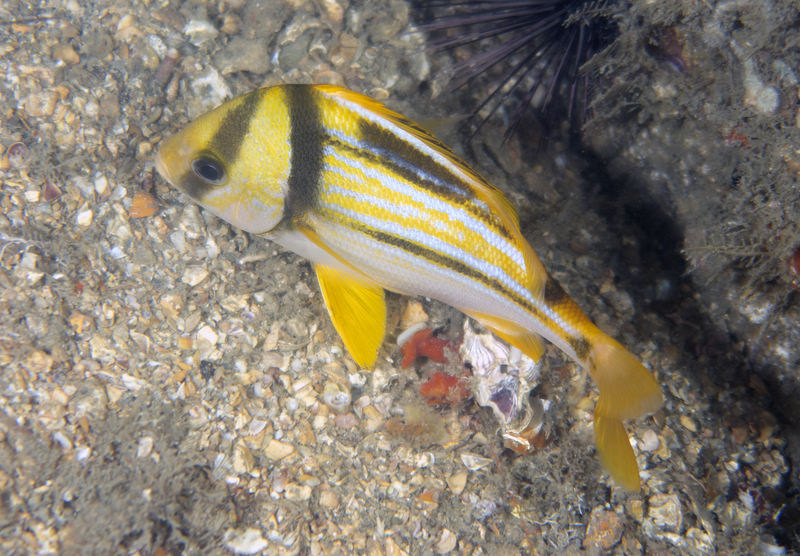
The porkfish (Anisotremus virginicus) is a colorful and distinctive marine fish found in the Western Atlantic Ocean, particularly in the Caribbean Sea and the Gulf of Mexico. Known for its unique appearance and engaging behavior, the porkfish is a member of the grunts family.
Porkfish are characterized by their striking coloration, featuring a silver body adorned with yellow and black stripes. The vivid contrast between the colors gives them a captivating and aesthetically pleasing appearance. Juvenile porkfish often display a black spot near the tail, gradually fading as they mature.
These fish are typically found in seagrass beds, coral reefs, and rocky areas, where they form schools with other individuals. The social nature of porkfish adds to their charm, as they engage in coordinated movements and group behaviors.
16. Stoplight Parrotfish
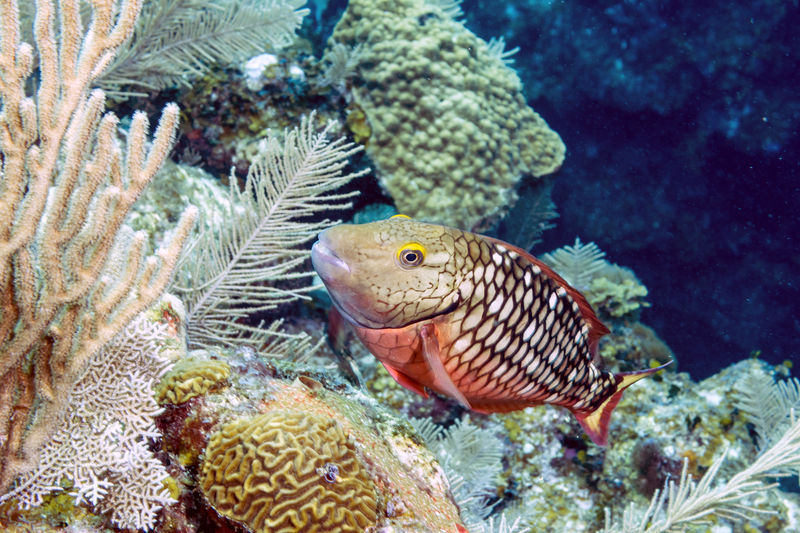
The stoplight parrotfish (Sparisoma viride) is a colorful and fascinating marine fish found in the Western Atlantic Ocean, particularly in the Caribbean Sea. Named for its vibrant coloration, the stoplight parrotfish is a member of the parrotfish family, known for its distinct appearance and important ecological role.
Stoplight parrotfish exhibit a unique color pattern, with a bright red or orange area near the head, a greenish midsection, and a yellow tail, resembling the colors of a traffic light. This striking coloration serves both as a form of camouflage among coral reefs and as a display of their species-specific markings.
17. Honeycomb Cowfish
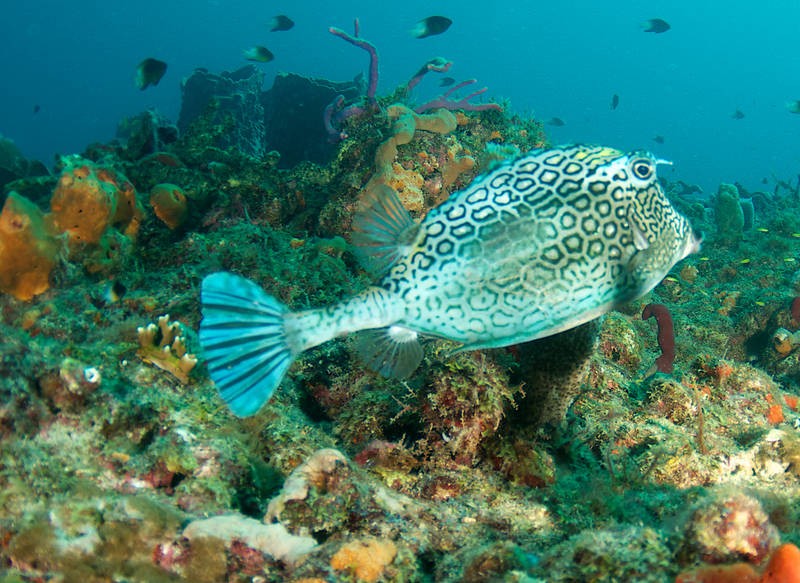
The honeycomb cowfish (Acanthostracion polygonius) is a distinctive and captivating marine fish found in the warm waters of the Western Atlantic, particularly in the Caribbean Sea and the Gulf of Mexico. This species is a member of the boxfish family and is known for its unique appearance and fascinating behavior.
The honeycomb cowfish derives its name from the hexagonal, honeycomb-like patterns on its outer skin. Its body is enclosed in a rigid, box-like carapace, providing protection against potential predators. The carapace also contributes to the fish’s buoyancy.
18. Nurse Shark
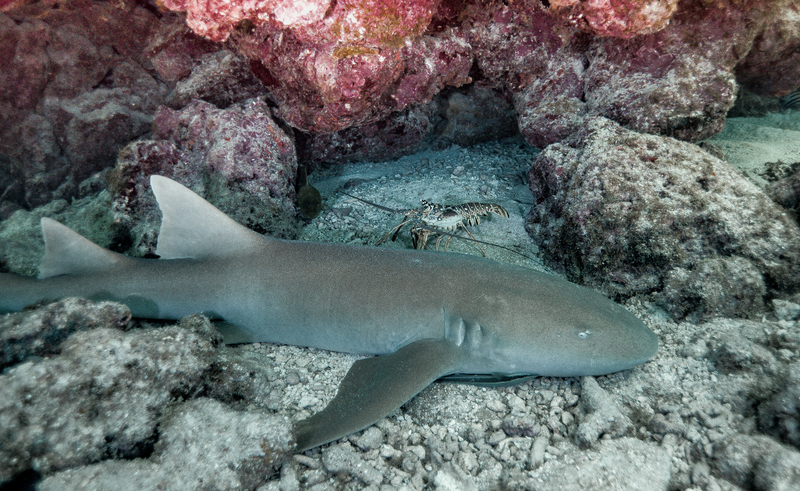
The nurse shark (Ginglymostoma cirratum) is a fascinating and relatively docile species of shark found in warm coastal waters, particularly in the Atlantic and eastern Pacific Oceans. Recognizable by its distinct features and behavior, the nurse shark is a popular species among divers and snorkelers.
Nurse sharks are characterized by their robust bodies, barbels (sensory organs) near their nostrils, and a wide mouth with small, serrated teeth. Their coloration typically ranges from light yellowish-brown to gray, providing effective camouflage against sandy and coral reef environments.
Known for their nocturnal habits, nurse sharks are often found resting on the ocean floor during the day. They are bottom-dwellers, preferring shallow waters near coral reefs, mangroves, and sandy flats. Nurse sharks are generally slow-moving, relying on their excellent sense of smell to locate prey, which includes crustaceans, small fish, and mollusks.
19. Green Moray Eel
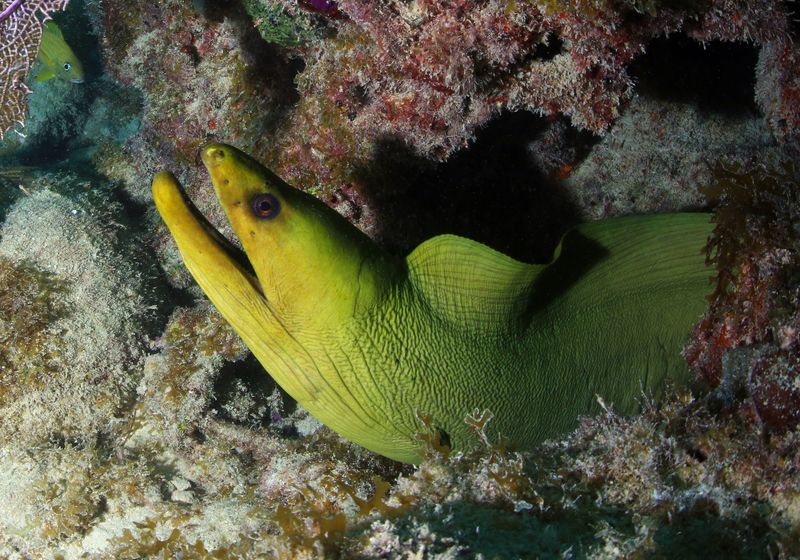
The green moray eel (Gymnothorax funebris) is a striking and fascinating marine creature found in the warm waters of the western Atlantic Ocean, including the Caribbean Sea and the Gulf of Mexico. Despite its name, the green moray eel is not always green; its coloration can vary from shades of green to brown, yellow, or even gray.
The most distinguishing feature of the green moray eel is its sinuous, elongated body, which lacks scales and is covered in a layer of mucus that gives it a distinctive appearance. Its mouth is wide, and it is filled with numerous sharp teeth. The eel’s eyes are small and often hidden within its skin, as it relies more on its acute sense of smell and vibration-sensitive skin to navigate its surroundings and locate prey.
Green moray eels are primarily nocturnal and are commonly found in rocky crevices, coral reefs, and other sheltered areas. They have a unique method of breathing using both gills and a specialized cavity in their mouths known as the buccal pump, which allows them to draw in water for oxygen exchange.
20. Spotted Trunkfish
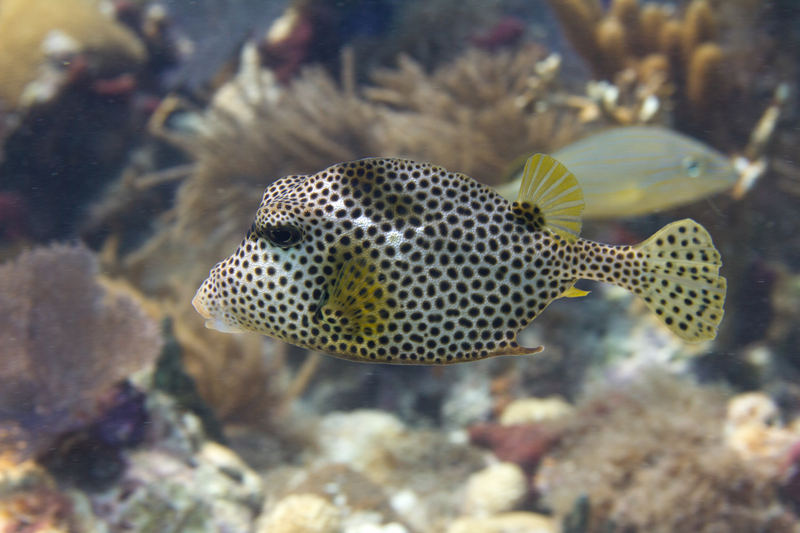
The spotted trunkfish (Lactophrys bicaudalis) is a charming and distinctive marine fish found in the warm waters of the Western Atlantic, particularly in the Caribbean Sea and the Gulf of Mexico. Known for its unique appearance and delightful markings, the spotted trunkfish is a member of the boxfish family.
This fish is characterized by its box-like body covered in hard, hexagonal plates, giving it a sturdy and protective structure. The spotted trunkfish is typically a yellowish to light brown color with numerous dark spots scattered across its body, which contribute to its name.
Spotted trunkfish are generally found in coral reefs, seagrass beds, and sandy areas, where they use their pectoral fins to move slowly and deliberately. They have a small mouth and feed primarily on small invertebrates, algae, and occasionally small crustaceans.
